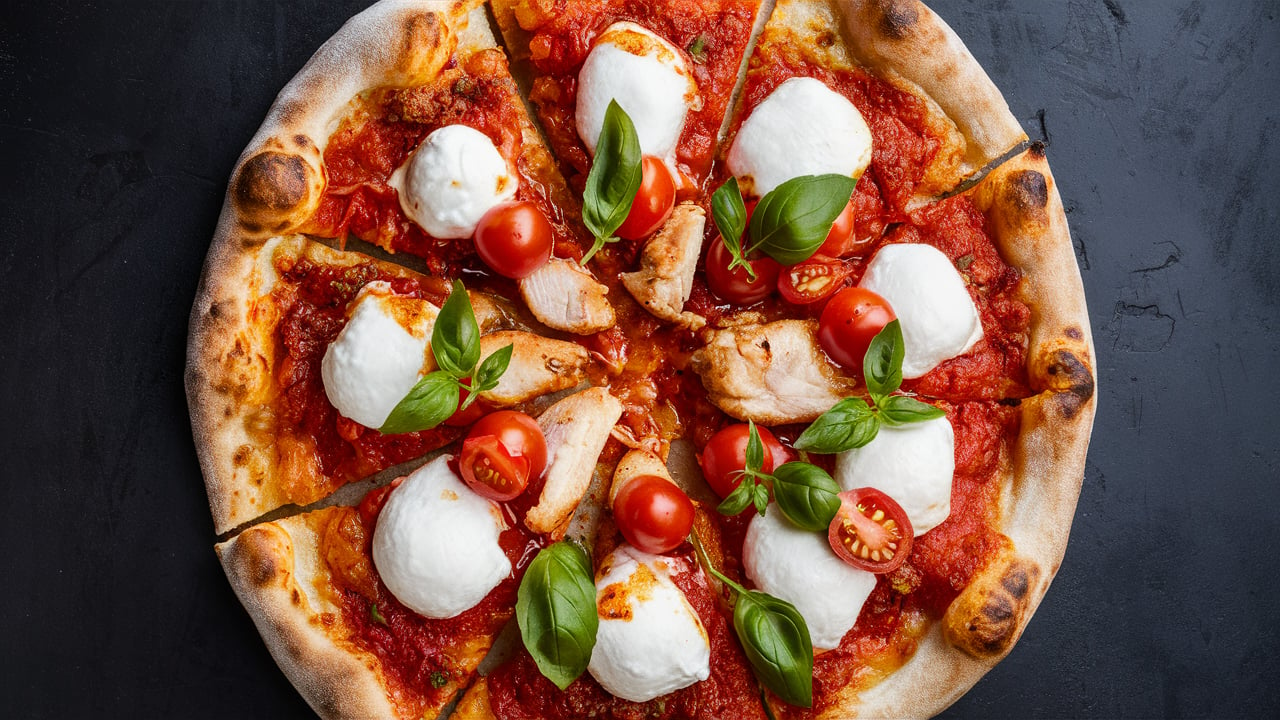Part 1: Understanding Chicken Margherita
Chicken Margherita is a popular and flavorful dish that draws inspiration from the classic Margherita pizza. Typically featuring grilled or baked chicken breast topped with fresh mozzarella, tomatoes, basil, and a drizzle of balsamic glaze, Chicken Margherita offers a lighter and healthier alternative to many other chicken dishes. The focus on fresh, whole ingredients makes it a standout choice for those who seek delicious meals that also contribute to their health and well-being.
In this article, we’ll dive deep into the nutritional content of Chicken Margherita, explore its health benefits, and offer actionable tips for making it even healthier. We’ll also provide internal and external linking opportunities to complement your culinary journey and help you create well-balanced meals.
What Is Chicken Margherita?
Chicken Margherita is a simple yet elegant dish that typically consists of the following components:
- Grilled or Baked Chicken Breast: The base of the dish is a lean chicken breast, which is often grilled or baked. This preparation method keeps the fat content low while preserving the protein and essential nutrients in the chicken.
- Fresh Mozzarella: A mild, soft cheese that adds creaminess and flavor without the heavy processing found in other cheeses. Fresh mozzarella contains fewer additives and is generally considered a healthier option.
- Tomatoes: Sliced fresh tomatoes or a light tomato sauce are usually added on top of the chicken. Tomatoes are rich in vitamins, antioxidants, and lycopene, which is beneficial for heart health.
- Fresh Basil: A few leaves of fresh basil give the dish its signature Margherita flavor. Basil adds a burst of freshness and is a good source of vitamins A, K, and antioxidants.
- Balsamic Glaze: A drizzle of balsamic glaze or vinegar adds sweetness and tang, enhancing the overall flavor of the dish without adding too many calories.
This combination of ingredients creates a flavorful and nutritious dish that balances lean protein, healthy fats, and fresh vegetables. For a balanced meal, you can pair Chicken Margherita with a refreshing salad like Broccoli Raisin Salad, which complements the richness of the chicken and cheese with a light and crunchy texture.
Nutritional Breakdown of Chicken Margherita
Understanding the nutritional content of Chicken Margherita is essential for those who are mindful of their calorie intake or are following specific dietary plans. Below is a detailed breakdown of the typical components of Chicken Margherita and their respective calorie counts:
- Grilled Chicken Breast
- Calories: 165 calories (4-ounce serving)
- Protein: 31 grams
- Fat: 3.6 grams
- Carbohydrates: 0 grams
- Fresh Mozzarella Cheese
- Calories: 85 calories (1-ounce serving)
- Protein: 6 grams
- Fat: 6 grams
- Carbohydrates: 1 gram
- Tomatoes
- Calories: 22 calories (1 medium-sized tomato)
- Protein: 1 gram
- Fat: 0 grams
- Carbohydrates: 5 grams
- Fresh Basil
- Calories: 1 calorie (1/4-cup serving)
- Protein: 0 grams
- Fat: 0 grams
- Carbohydrates: 0.2 grams
- Balsamic Glaze
- Calories: 30 calories (1-tablespoon serving)
- Protein: 0 grams
- Fat: 0 grams
- Carbohydrates: 8 grams
When we combine these ingredients, the total calorie estimate for a standard serving of Chicken Margherita is approximately 303 calories. This makes it a relatively light option compared to other chicken dishes, especially those that are fried or prepared with heavy sauces.
However, the calorie count can vary depending on several factors such as portion size, type of cheese, and cooking methods. In the next section, we’ll explore the factors that can influence the overall calorie count of this dish and how to adjust them to suit your dietary needs.
Factors That Can Affect the Calorie Count
While the base recipe for Chicken Margherita is fairly light, several factors can influence the overall calorie count. Let’s take a closer look at these factors:
- Portion Size
The size of the chicken breast and the amount of mozzarella cheese used can significantly impact the calorie content of the dish. For example, using a larger chicken breast (e.g., 6 ounces instead of 4) can add an additional 80 calories. Similarly, using more mozzarella will increase the calorie and fat content. To keep the calorie count in check, consider sticking to standard portion sizes or opting for leaner cuts of chicken.
- Type of Cheese
While fresh mozzarella is commonly used in Chicken Margherita, some variations may include other types of cheese, such as regular mozzarella, Parmesan, or even a blend of cheeses. Harder cheeses like Parmesan are typically more calorie-dense, so using them can increase the overall calorie count of the dish. Opting for a lower-fat version of mozzarella or reducing the cheese portion can help lower the calorie and fat content without compromising flavor.
- Cooking Method
Grilling or baking the chicken is the healthiest method of preparation for this dish, as these methods use minimal added fats. However, if the chicken is cooked in butter or oil, or if additional fats are used during the cooking process, the calorie content will increase. Choosing a light cooking spray or grilling the chicken without added oils can help keep the calorie count low. For a lighter, healthier meal, consider pairing your Chicken Margherita with a side of Gluten-Free Zucchini Bread, which complements the dish with a low-carb, nutritious option.
Factors That Can Affect the Calorie Count
- Amount of Balsamic Glaze
Balsamic glaze is often drizzled over Chicken Margherita to add sweetness and acidity. While it’s a flavorful addition, using more than the standard tablespoon can add unnecessary calories. Consider using balsamic vinegar instead of glaze if you’re trying to cut down on sugar and calories. A small drizzle of glaze can go a long way in enhancing the flavor of the dish without significantly increasing the calorie content.
- Additional Ingredients
Some variations of Chicken Margherita may include extras like olive oil, garlic, or a tomato-based sauce. While these ingredients add flavor and nutrients, they can also add calories, especially if used in larger quantities. Being mindful of how much you add can help you keep the dish light and healthy.
For more tips on making Chicken Margherita healthier, explore this Grilled Chicken Margherita Recipe, which offers insights into optimizing the dish for nutrition and flavor.
Health Benefits of Chicken Margherita
Chicken Margherita offers several health benefits, making it a great choice for those looking to eat a balanced and nutritious meal. Here are some of the key benefits:
- High in Protein
Chicken breast is an excellent source of lean protein, which is essential for muscle repair, immune function, and overall health. A typical serving of Chicken Margherita provides around 31 grams of protein, making it a satisfying meal that can help keep you full for longer.
- Rich in Vitamins and Antioxidants
Tomatoes and basil are rich in vitamins A and C, as well as antioxidants like lycopene. Lycopene, found in tomatoes, has been linked to a reduced risk of heart disease and certain types of cancer. Basil adds additional antioxidants, which can help protect your body from oxidative stress and inflammation.
Health Benefits of Chicken Margherita
- Low in Carbohydrates
Chicken Margherita is naturally low in carbohydrates, making it a great option for those following a low-carb or ketogenic diet. The majority of the carbohydrates in this dish come from the tomatoes and balsamic glaze, which are relatively low in carbs and provide additional nutrients. For a similar low-carb meal, try this Healthy Gluten-Free Bread Recipe, which pairs well with Chicken Margherita.
- Lower in Calories Compared to Other Chicken Dishes
With approximately 300 calories per serving, Chicken Margherita is a lighter option compared to many other chicken dishes, such as fried chicken or chicken Parmesan. This makes it a good choice for those looking to maintain or lose weight without sacrificing flavor. The use of fresh, whole ingredients ensures that you’re getting the most nutritional value without unnecessary additives or empty calories.
- Good Source of Calcium
Mozzarella cheese provides a decent amount of calcium, which is essential for maintaining strong bones and teeth. While it’s important not to overdo the cheese, a moderate portion can contribute to your daily calcium needs. For an extra boost of nutrition, you can add more vegetables to the dish, such as spinach or bell peppers, which will increase the fiber and vitamin content without adding many calories.
For more health-conscious chicken dishes, you might want to explore this Chicken Broccoli Salad, which offers a perfect blend of lean protein, healthy fats, and nutrient-dense vegetables.
Part 2: Tips for Making Chicken Margherita Healthier
While Chicken Margherita is already a healthy dish, there are several ways to make it even lighter and more nutritious. Here are some tips:
- Use a Smaller Portion of Cheese
Reducing the amount of mozzarella cheese can help lower the calorie and fat content of the dish. You can also opt for a lower-fat version of mozzarella or use just a sprinkle of Parmesan for added flavor without the extra calories. By using less cheese, you can still enjoy the creamy texture without overloading the dish with fat.
- Increase the Vegetables
Adding more vegetables to your Chicken Margherita is an easy way to boost its nutritional value. Consider adding roasted or sautéed veggies like zucchini, bell peppers, or spinach to increase the fiber, vitamins, and minerals in your meal. Vegetables add volume and texture to the dish without significantly increasing the calorie content, making it a more satisfying and balanced meal.
Part 2: Tips for Making Chicken Margherita Healthier
- Swap Balsamic Glaze for Balsamic Vinegar
If you’re trying to cut down on sugar and calories, consider swapping balsamic glaze for balsamic vinegar. Vinegar provides the same tangy flavor without the added sugars that come from reducing the vinegar into a glaze. This simple swap can help you enjoy the rich flavors of Chicken Margherita while keeping the calorie count low.
- Use a Healthier Cooking Method
Stick to grilling, baking, or broiling the chicken to keep the fat content low. Avoid frying the chicken or cooking it in large amounts of butter or oil, as this can significantly increase the calorie count. Using a non-stick pan or cooking spray can help reduce the need for added fats while still achieving a flavorful and tender result.
- Serve with a Side Salad or Whole Grains
To make your Chicken Margherita a more balanced meal, serve it with a side of leafy greens or a portion of whole grains like quinoa or brown rice. This will add fiber, vitamins, and minerals to your meal, making it more filling and nutritious. You can also consider pairing it with this Broccoli Cauliflower Salad, which adds a crunchy and refreshing element to the dish.
By incorporating these healthy tips into your Chicken Margherita recipe, you can enjoy a delicious and nutritious meal that aligns with your dietary goals. Whether you’re looking to cut calories, reduce carbs, or simply add more nutrients to your diet, these simple adjustments can make a big difference.
Conclusion: How Many Calories Are in a Chicken Margherita?
In conclusion, Chicken Margherita is a delicious and nutritious dish that can easily fit into a healthy eating plan. With approximately 300 calories per serving, it provides a good balance of lean protein, healthy fats, and essential nutrients. By making smart ingredient choices, such as using a smaller portion of cheese, opting for grilling or baking instead of frying, and adding more vegetables, you can enjoy this flavorful dish while keeping it light and healthy.
Whether you’re following a specific diet or simply looking for a tasty and balanced meal, Chicken Margherita offers a great option that can be customized to suit your needs. For a complete meal, consider pairing Chicken Margherita with a side dish like Broccoli Raisin Salad or Healthy Gluten-Free Bread for added nutrition and flavor.

